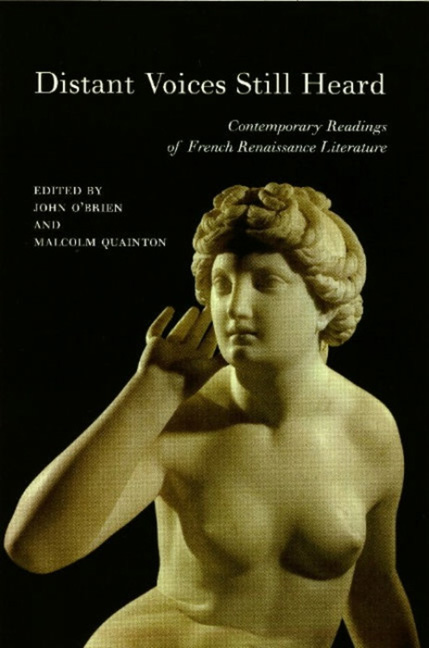Book contents
- Frontmatter
- Contents
- Editors’ Foreword
- Introduction: The Time of Theory
- 1 The Highs and Lows of Structuralist Reading: Rabelais, Pantagruel, chapters 10—13
- 2 Rabelais’ Strength and the Pitfalls of Methodology: Tiers Livre, chapters 7–18
- 3 ‘Blond chef, grande conqueste’: Feminist Theories of the Gaze, the blason anatomique and Louise Labé's Sonnet 6
- 4 Louise Labé's Feminist Poetics
- 5 Reading and Writing in the Tenth Story of the Heptaméron
- 6 Fetishism and Storytelling in Nouvelle 57 of Marguerite de Navarre's Heptaméron
- 7 Creative Choreography: Intertextual Dancing in Ronsard's Sonnets pour Hélène: II, 30
- 8 An Overshadowed Valediction: Ronsard's Dedicatory Epistle to Villeroy
- 9 ‘De l'amitié’ (Essais 1.28): ‘Luy’ and ‘Moy’
- 10 Montaigne's Death Sentences: Narrative and Subjectivity in ‘De la diversion’ (Essais 3.4)
- Select Bibliography
- Index
Introduction: The Time of Theory
- Frontmatter
- Contents
- Editors’ Foreword
- Introduction: The Time of Theory
- 1 The Highs and Lows of Structuralist Reading: Rabelais, Pantagruel, chapters 10—13
- 2 Rabelais’ Strength and the Pitfalls of Methodology: Tiers Livre, chapters 7–18
- 3 ‘Blond chef, grande conqueste’: Feminist Theories of the Gaze, the blason anatomique and Louise Labé's Sonnet 6
- 4 Louise Labé's Feminist Poetics
- 5 Reading and Writing in the Tenth Story of the Heptaméron
- 6 Fetishism and Storytelling in Nouvelle 57 of Marguerite de Navarre's Heptaméron
- 7 Creative Choreography: Intertextual Dancing in Ronsard's Sonnets pour Hélène: II, 30
- 8 An Overshadowed Valediction: Ronsard's Dedicatory Epistle to Villeroy
- 9 ‘De l'amitié’ (Essais 1.28): ‘Luy’ and ‘Moy’
- 10 Montaigne's Death Sentences: Narrative and Subjectivity in ‘De la diversion’ (Essais 3.4)
- Select Bibliography
- Index
Summary
Have we anything still to learn from literary theory? The question could be phrased in another way and in another tense: was there anything ever to be learned from literary theory? The switch in tense and its modifying adverb contains a history as well as an outlook. For supporters of the second question, the moment of literary theory has a specific history, and one that is now past; it is linked to a constellation of names – Barthes, Lacan, Foucault, Derrida, to name only the most obvious – and to a period of time in the third to last quarter of the twentieth century that appears passé as we enter the twenty-first century. On this view, the moment of theory was just that – a moment describable in the past tense and seen as a fragment of a longer perspective, a longer view which is synonymous with the sweep of literary history. Theory thus represents a detour on the pathway of history, a moment when time was temporarily out of joint.
The question of time and tense is at the heart of the issue which theory carries along with it, and no less so when we come to speak about theory and French sixteenth-century literature. For in Renaissance studies, it is tied to the problem of anachronism and periodicity. If one wanted to chose a symptomatic moment when this cluster of points surfaced directly in the study of the sixteenth century, it might be the rejoinder made by the French Renaissance scholar, Jean-Claude Margolin, to the opening chapter of Foucault's Les mots et les choses. In that chapter, Foucault had claimed that the key to the Renaissance outlook is interpretation; knowledge of the world depends upon the ability to recognise, read and organise signs. Things are linked to each other through the theory of resemblances, such resemblances being recognisable and decipherable because they bear within them ‘signatures’.
- Type
- Chapter
- Information
- Distant Voices Still HeardContemporary Readings of French Renaissance Literature, pp. 1 - 52Publisher: Liverpool University PressPrint publication year: 2000



